Paper Menu >>
Journal Menu >>
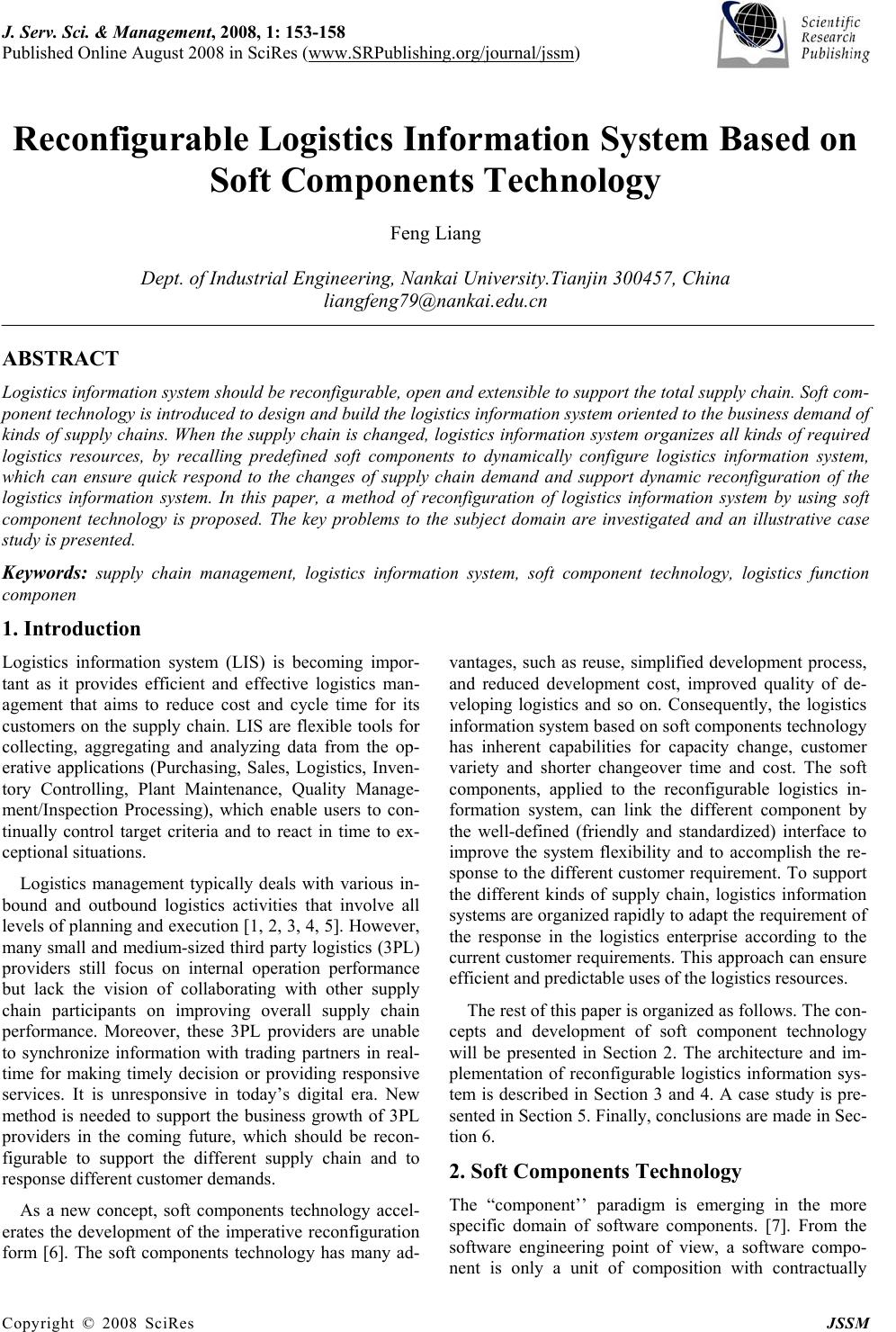 J. Serv. Sci. & Management, 2008, 1: 153-158 Published Online August 2008 in SciRes (www.SRPublishing.org/journal/jssm) Copyright © 2008 SciRes JSSM Reconfigurable Logistics Information System Based on Soft Components Technology Feng Liang Dept. of Industrial Engineering, Nankai University.Tianjin 300457, China liangfeng79@nankai.edu.cn ABSTRACT Logistics information system should be reconfigurable, open and extensible to support the total supply chain. Soft com- ponent technology is introduced to design and build the logistics information system oriented to the business demand of kinds of supply chains. When the supply chain is changed, logistics information system organizes all kinds of required logistics resources, by recalling predefined soft components to dynamically configure logistics information system, which can ensure quick respond to the changes of supply chain demand and support dynamic reconfiguration of the logistics information system. In this paper, a method of reconfiguration of logistics information system by using soft component technology is proposed. The key problems to the subject domain are investigated and an illustrative case study is presented. Keywords: supply chain management, logistics information system, soft component technology, logistics function componen 1. Introduction Logistics information system (LIS) is becoming impor- tant as it provides efficient and effective logistics man- agement that aims to reduce cost and cycle time for its customers on the supply chain. LIS are flexible tools for collecting, aggregating and analyzing data from the op- erative applications (Purchasing, Sales, Logistics, Inven- tory Controlling, Plant Maintenance, Quality Manage- ment/Inspection Processing), which enable users to con- tinually control target criteria and to react in time to ex- ceptional situation s . Logistics management typically deals with various in- bound and outbound logistics activities that involve all levels of planning and execution [1, 2, 3, 4, 5]. However, many small and medium-sized third party logistics (3PL) providers still focus on internal operation performance but lack the vision of collaborating with other supply chain participants on improving overall supply chain performance. Moreover, these 3PL providers are unable to synchronize information with trading partners in real- time for making timely decision or providing responsive services. It is unresponsive in today’s digital era. New method is needed to support the business growth of 3PL providers in the coming future, which should be recon- figurable to support the different supply chain and to response different customer demands. As a new concept, soft components technology accel- erates the development of the imperative reconfiguration form [6]. The soft components technology has many ad- vantages, such as reuse, simplified development process, and reduced development cost, improved quality of de- veloping logistics and so on. Consequently, the logistics information system based on soft components technology has inherent capabilities for capacity change, customer variety and shorter changeover time and cost. The soft components, applied to the reconfigurable logistics in- formation system, can link the different component by the well-defined (friendly and standardized) interface to improve the system flexibility and to accomplish the re- sponse to the different customer requirement. To support the different kinds of supply chain, logistics information systems are organized rapidly to adapt the requirement of the response in the logistics enterprise according to the current customer requirements. This approach can ensure efficient and predictable uses of the logistics resources. The rest of this paper is organized as follows. The con- cepts and development of soft component technology will be presented in Section 2. The architecture and im- plementation of reconfigurable logistics information sys- tem is described in Section 3 and 4. A case study is pre- sented in Section 5. Finally, conclusions are made in Sec- tion 6. 2. Soft Components Technology The “component’’ paradigm is emerging in the more specific domain of software components. [7]. From the software engineering point of view, a software compo- nent is only a unit of composition with contractually 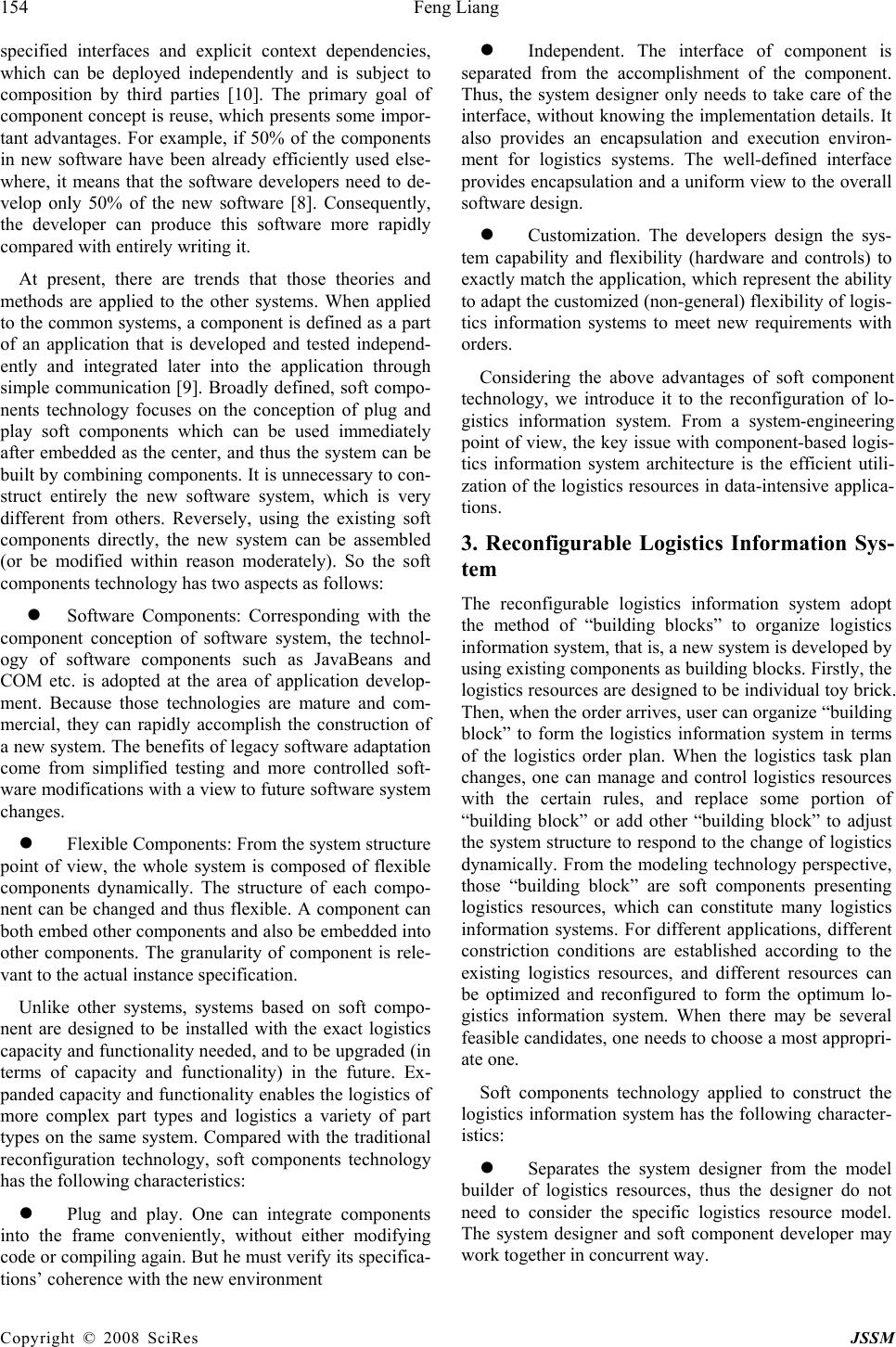 154 Feng Liang Copyright © 2008 SciRes JSSM specified interfaces and explicit context dependencies, which can be deployed independently and is subject to composition by third parties [10]. The primary goal of component concept is reuse, which presents some impor- tant advantages. For example, if 50% of the components in new software have been already efficiently used else- where, it means that the software developers need to de- velop only 50% of the new software [8]. Consequently, the developer can produce this software more rapidly compared with entirely writing it. At present, there are trends that those theories and methods are applied to the other systems. When applied to the common systems, a component is defined as a part of an application that is developed and tested independ- ently and integrated later into the application through simple communication [9]. Broadly defined, soft compo- nents technology focuses on the conception of plug and play soft components which can be used immediately after embedded as the center, and thus the system can be built by combining components. It is unnecessary to con- struct entirely the new software system, which is very different from others. Reversely, using the existing soft components directly, the new system can be assembled (or be modified within reason moderately). So the soft components technology has two aspects as follows: z Software Components: Corresponding with the component conception of software system, the technol- ogy of software components such as JavaBeans and COM etc. is adopted at the area of application develop- ment. Because those technologies are mature and com- mercial, they can rapidly accomplish the construction of a new system. The benefits of legacy software adaptation come from simplified testing and more controlled soft- ware modifications with a view to future software system changes. z Flexible Components: From the system structure point of view, the whole system is composed of flexible components dynamically. The structure of each compo- nent can be changed and thus flexible. A component can both embed other components and also be embedded into other components. The granularity of component is rele- vant to the actual instance specification. Unlike other systems, systems based on soft compo- nent are designed to be installed with the exact logistics capacity and functionality needed, and to be upgraded (in terms of capacity and functionality) in the future. Ex- panded capacity and functio nality enables the logistics of more complex part types and logistics a variety of part types on the same system. Compared with the traditional reconfiguration technology, soft components technology has the following characteristics: z Plug and play. One can integrate components into the frame conveniently, without either modifying code or compiling again. But he must verify its specifica- tions’ coherence with the new environment z Independent. The interface of component is separated from the accomplishment of the component. Thus, the system designer only needs to take care of the interface, without knowing the implementation details. It also provides an encapsulation and execution environ- ment for logistics systems. The well-defined interface provides encapsulation and a uniform view to the overall software design. z Customization. The developers design the sys- tem capability and flexibility (hardware and controls) to exactly match the application, which represent the ability to adapt the customized (non-general) flexibility of logis- tics information systems to meet new requirements with orders. Considering the above advantages of soft component technology, we introduce it to the reconfiguration of lo- gistics information system. From a system-engineering point of view, the key issue with component-based logis- tics information system architecture is the efficient utili- zation of the logistics resources in data-intensive applica- tions. 3. Reconfigurable Logistics Information Sys- tem The reconfigurable logistics information system adopt the method of “building blocks” to organize logistics information system, that is, a new system is developed by using existing components as building blocks. Firstly, the logistics resources are designed to be individual toy brick. Then, when the order arrives, user can organize “building block” to form the logistics information system in terms of the logistics order plan. When the logistics task plan changes, one can manage and control logistics resources with the certain rules, and replace some portion of “building block” or add other “building block” to adjust the system structure to respond to the change of logistics dynamically. From the modeling technology perspective, those “building block” are soft components presenting logistics resources, which can constitute many logistics information systems. For different applications, different constriction conditions are established according to the existing logistics resources, and different resources can be optimized and reconfigured to form the optimum lo- gistics information system. When there may be several feasible candidates, one needs to choose a most appropri- ate one. Soft components technology applied to construct the logistics information system has the following character- istics: z Separates the system designer from the model builder of logistics resources, thus the designer do not need to consider the specific logistics resource model. The system designer and soft component developer may work together in concurrent way.  Reconfigurable Logistics Information System Based on Soft Components Technology 155 Copyright © 2008 SciRes JSSM z Enhance the system flexibility. Given logistics tasks, the required system can be constituted by the cor- responding soft components stored in the components library. And the system does not need to be designed entirely, which ensure that the similar function parts are not repeatedly written. As thu s, it not only enhances sys- tem flexibility but also improves the planners’ efficiency. z Elevate the system openness. By hiding and en- capsulating the structural details of data and algorithms that underpin the logistics system and logistics resources, and by supplying a specification interface to the user, the soft component technology offers a high openness. But in integrating a component into a new environment, one must verify its specifications’ coherence with the new environment, which ensures that the function is not dis- rupted by its use mode. [10] z Improve the system agility. When the condition changes or the resources conflicts, one can schedule the logistics resources effectively, and reconfigure the logis- tics system rapidly. Therefore, using the soft components technology, the logistics information system can realize the dynamic change of system structure to respond the change of sup- ply chain environment and logistics task, which makes it suitable to the different type of logistics applications. Furthermore, along with the above procedure, the do- main-public soft components library will be formed gradually, which can be applied to the different applica- tions to amplify the system generalization. 4. System Implementation It is very complicated that how to design reconfigurable logistics information system. Figure 1 shows that the development procedure of soft component-based system is a concurrent and two-dimensional procedure, where the system planner is separated from the model developer of logistics resources. From the system planner perspec- tive, it follows the common development procedure, namely requirement analyzing, system simple design, system detailed design, assembling & testing, and logis- tics delivery, etc. In this step, close-loop control is intro- duced to feedback the required information, which con- tributes to the designers to solve the problems arisen in practice. On the other hand, from the soft component developer perspective, it represents soft component de- velopment procedure, which consists of group classifying, characteristic distilling, and component test. In this mode, soft component technology encapsulates machines as virtual devices, making the architecture more under- standable for software developers. In the following sec- tion, we will discuss the two p rocedures in detail. 4.1. System Planning To develop soft component-based system, it is necessary to divide the application into components. So the first step to be considered is to have an investigation on do- main analysis, which helps to the understanding of a problem and its solution components. This analysis al- lows for identifying and classifying by types of themes treated, which plays a key role in th e iden tification of soft components. From the analysis, a list of domains that characterize the activities of logistics task planning is established. At his stage, the whole system is divided into three parts: common part, reusable part (which is relevant to some domain) and special part. As a consequence, the components can be classified into the following three classes based on functionality: Generic Component (GC), Domain-Generic Component (DGC) and Domain- Specific Component (DSC). The design steps are dis- cussed as follows: Build genetic component. It is obvious that there are some basic parts in a common system, which are to provide some genetic service, such as database management part, network connect part, etc. These generic components could be used as basic service to build other systems, which are genetic elements inde- pendent of the considered problem and specific elements dedicated to the developed system [7]. These generic models are obtained after an analysis of a domain, which make the architecture adaptable to various kinds of appli- cations. It is horizontal reuse, which consists of using generic components in different applications. Design domain-generic component Domain-generic component is a special component that contributes some genetic services to a special domain, which is only applied in some special applications. The group technology (GT) is introduced to classify the logis- tics resources frequently, which is based on the principle of grouping similar parts into families. Given different orders, the different components are assembled to con- struct the oriented- order system. During this period, the particular information flow of a special order need not be considered, because the following domain-special com- ponents should be assembled to meet the special demands. This is a vertical reuse which means that components are specific to a domain of expertise or implementation. Its objective is to derive generic models from a family of systems in some domain. Develop domain-special component The goal of domain-special component is to provide some special services for a special order in a special domain. After investigating the enterprise and building the above basic module, the developer can design the domain- special components to construct the oriented-order logis- tics system. The steps of system design flow are illustrated as fol- lows: when the logistics task arrives, job shop controller assign the tasks to the corresponding system controller, which will form the oriented- order logistics system in terms of adding component directly, selecting appropriate 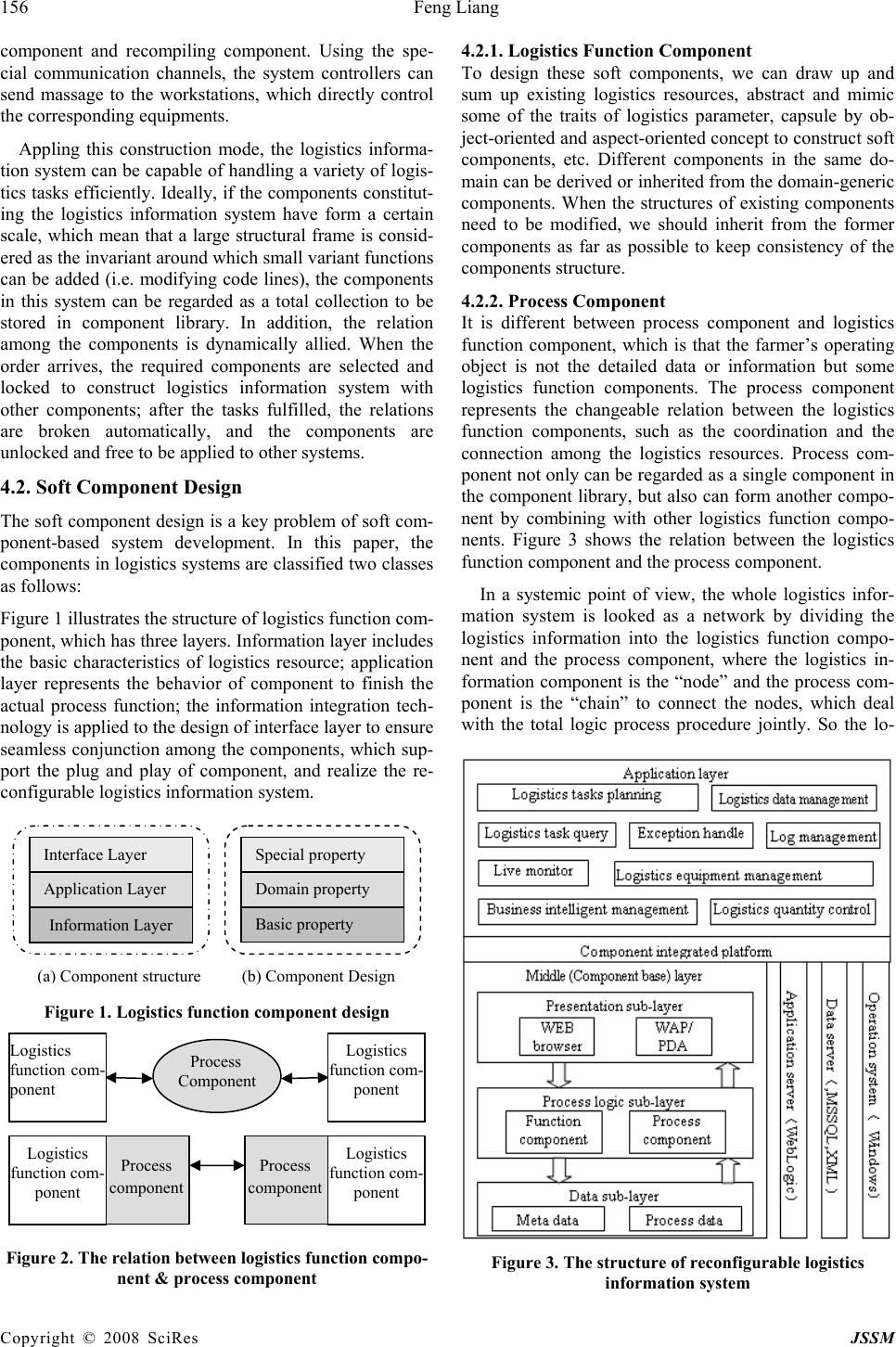 156 Feng Liang Copyright © 2008 SciRes JSSM component and recompiling component. Using the spe- cial communication channels, the system controllers can send massage to the workstations, which directly control the corresponding equipments. Appling this construction mode, the logistics informa- tion system can be capable of handling a variety of logis- tics tasks efficiently. Ideally, if the components constitut- ing the logistics information system have form a certain scale, which mean that a large structural frame is consid- ered as the invariant around which small variant functions can be added (i.e. modifying code lines), the components in this system can be regarded as a total collection to be stored in component library. In addition, the relation among the components is dynamically allied. When the order arrives, the required components are selected and locked to construct logistics information system with other components; after the tasks fulfilled, the relations are broken automatically, and the components are unlocked and free to be applied to other systems. 4.2. Soft Component Design The soft component design is a key problem of soft com- ponent-based system development. In this paper, the components in logistics systems are classified two classes as follows: Figure 1 illustrates the stru cture of logistics function com- ponent, which has three layers. Information layer includes the basic characteristics of logistics resource; application layer represents the behavior of component to finish the actual process function; the information integration tech- nology is applied to the design of interface layer to ensure seamless conjunction among the components, which sup- port the plug and play of component, and realize the re- configurable logistics information system. Figure 1. Logistics function component design Figure 2. The relation between logistics function compo- nent & process component 4.2.1. Logistics Function Component To design these soft components, we can draw up and sum up existing logistics resources, abstract and mimic some of the traits of logistics parameter, capsule by ob- ject-oriented and aspect-oriented concept to construct soft components, etc. Different components in the same do- main can be derived or inherited from the domain-generic components. When the structures of existing components need to be modified, we should inherit from the former components as far as possible to keep consistency of the components structure. 4.2.2. Process Component It is different between process component and logistics function component, which is that the farmer’s operating object is not the detailed data or information but some logistics function components. The process component represents the changeable relation between the logistics function components, such as the coordination and the connection among the logistics resources. Process com- ponent not only can be regarded as a single component in the component library, but also can form another compo- nent by combining with other logistics function compo- nents. Figure 3 shows the relation between the logistics function component and the process component. In a systemic point of view, the whole logistics infor- mation system is looked as a network by dividing the logistics information into the logistics function compo- nent and the process component, where the logistics in- formation component is the “node” and the process com- ponent is the “chain” to connect the nodes, which deal with the total logic process procedure jointly. So the lo- Figure 3. The structure of reconfigurable logistics information system Information Layer Application Layer Interface Layer ( a ) Com p onent structure Basic property Domain property Special property (b) Component Design Process Component Process component Logistics function com- ponent Process component Logistics function com- ponent Logistics function com- ponent Logistics function com- ponent 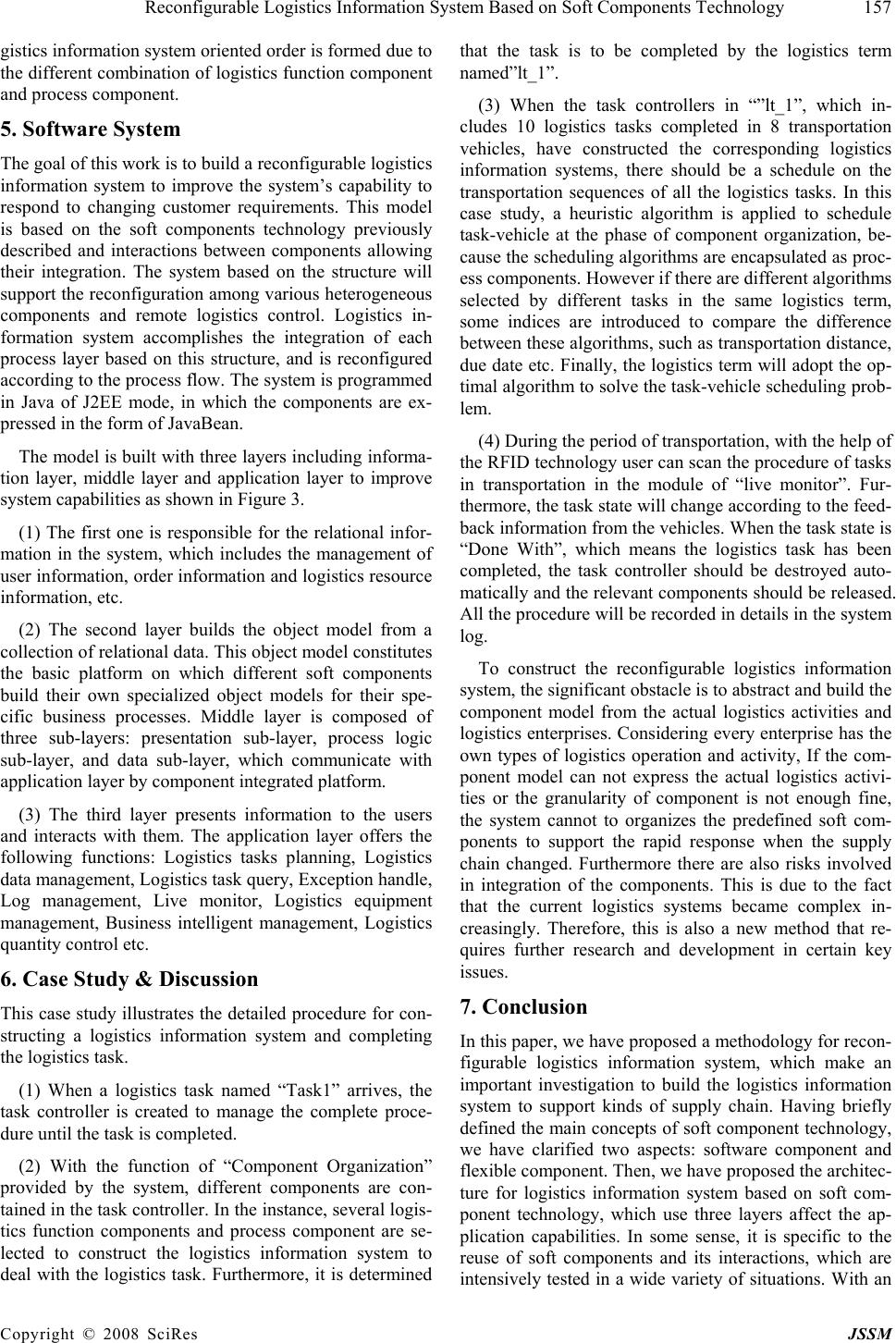 Reconfigurable Logistics Information System Based on Soft Components Technology 157 Copyright © 2008 SciRes JSSM gistics information system oriented order is formed due to the different combination of logistics function component and process component. 5. Software System The goal of this work is to build a recon fig ur able lo gistics information system to improve the system’s capability to respond to changing customer requirements. This model is based on the soft components technology previously described and interactions between components allowing their integration. The system based on the structure will support the reconfiguration among various heterogeneous components and remote logistics control. Logistics in- formation system accomplishes the integration of each process layer based on this structure, and is reconfigured according to the process flow. The system is programmed in Java of J2EE mode, in which the components are ex- pressed in the form of JavaBean. The model is built with three layers including informa- tion layer, middle layer and application layer to improve system capabilities as shown in Figur e 3. (1) The first one is responsible for the relational infor- mation in the system, which includes the management of user information, order information and logistics resource information, etc. (2) The second layer builds the object model from a collection of relatio nal data. Th is obj ect model constitu tes the basic platform on which different soft components build their own specialized object models for their spe- cific business processes. Middle layer is composed of three sub-layers: presentation sub-layer, process logic sub-layer, and data sub-layer, which communicate with application layer by component integrated platform. (3) The third layer presents information to the users and interacts with them. The application layer offers the following functions: Logistics tasks planning, Logistics data management, Logistics task query, Exception handle, Log management, Live monitor, Logistics equipment management, Business intelligent management, Logistics quantity control etc. 6. Case Study & Discussion This case study illustrates the detailed p rocedure for con- structing a logistics information system and completing the logistics task. (1) When a logistics task named “Task1” arrives, the task controller is created to manage the complete proce- dure until the task is completed. (2) With the function of “Component Organization” provided by the system, different components are con- tained in the task controller. In the instan ce, several logis- tics function components and process component are se- lected to construct the logistics information system to deal with the logistics task. Furthermore, it is determined that the task is to be completed by the logistics term named”lt_1”. (3) When the task controllers in “”lt_1”, which in- cludes 10 logistics tasks completed in 8 transportation vehicles, have constructed the corresponding logistics information systems, there should be a schedule on the transportation sequences of all the logistics tasks. In this case study, a heuristic algorithm is applied to schedule task-vehicle at the phase of component organization, be- cause the scheduling algorithms are encapsulated as proc- ess components. However if there are different algorithms selected by different tasks in the same logistics term, some indices are introduced to compare the difference between these algorithms, such as transportation distance, due date etc. Finally, the logistics term will adopt the op- timal algorithm to solve the task-vehicle sche duling pr ob- lem. (4) During the period of transportation, with the help of the RFID technology user can scan the procedure of tasks in transportation in the module of “live monitor”. Fur- thermore, the task state will change according to the feed- back information from the vehicles. When the task state is “Done With”, which means the logistics task has been completed, the task controller should be destroyed auto- matically and the relevant components should be released. All the procedur e will be record ed in d etails in th e system log. To construct the reconfigurable logistics information system, the significant obstacle is to abstract and build the component model from the actual logistics activities and logistics enterprises. Considerin g every enterprise has the own types of logistics operation and activity, If the com- ponent model can not express the actual logistics activi- ties or the granularity of component is not enough fine, the system cannot to organizes the predefined soft com- ponents to support the rapid response when the supply chain changed. Furthermore there are also risks involved in integration of the components. This is due to the fact that the current logistics systems became complex in- creasingly. Therefore, this is also a new method that re- quires further research and development in certain key issues. 7. Conclusion In this paper, we have proposed a methodology for recon- figurable logistics information system, which make an important investigation to build the logistics information system to support kinds of supply chain. Having briefly defined the main concepts of soft component technology, we have clarified two aspects: software component and flexible component. Then, we have proposed the architec- ture for logistics information system based on soft com- ponent technology, which use three layers affect the ap- plication capabilities. In some sense, it is specific to the reuse of soft components and its interactions, which are intensively tested in a wide variety of situations. With an 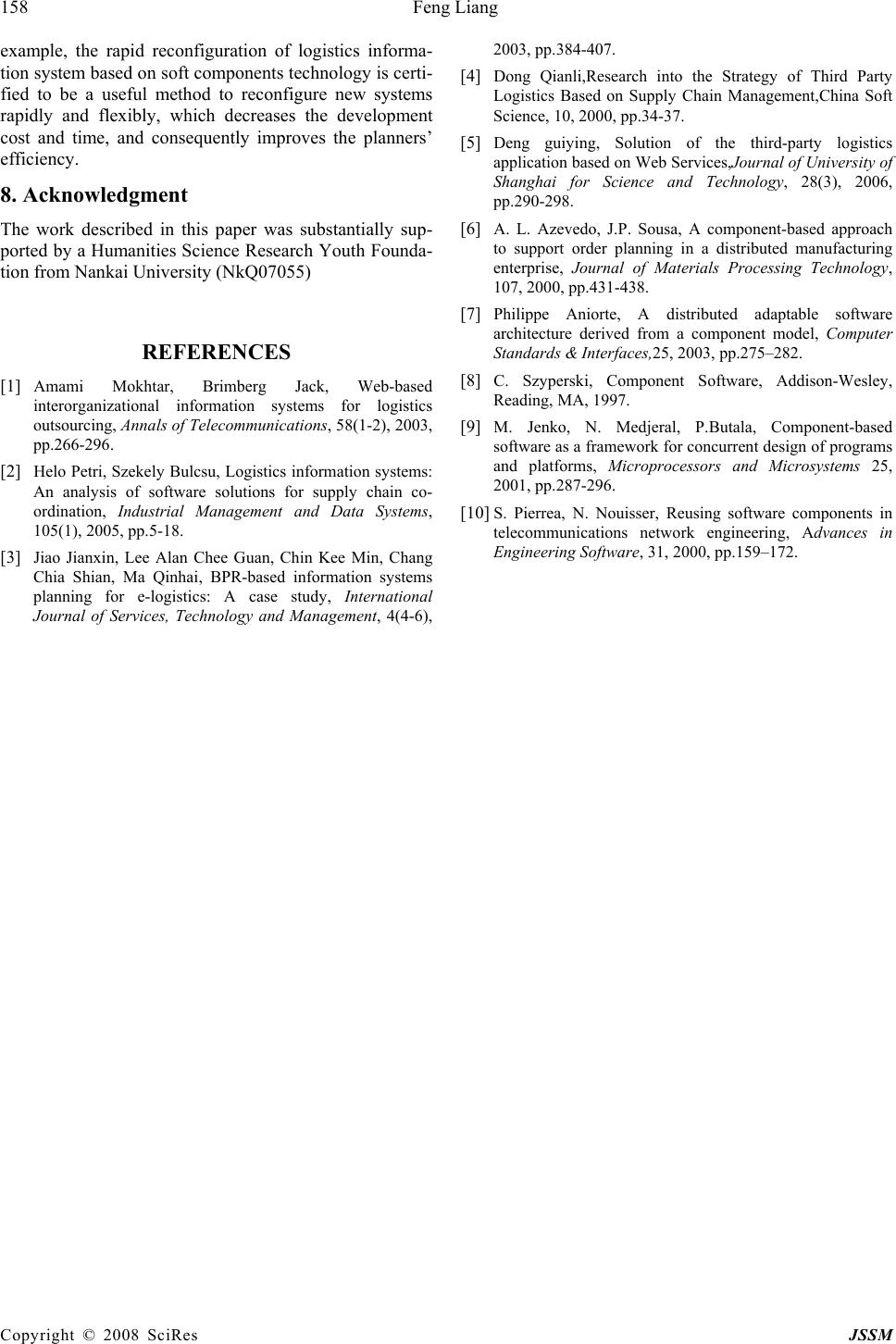 158 Feng Liang Copyright © 2008 SciRes JSSM example, the rapid reconfiguration of logistics informa- tion system based on soft components technology is certi- fied to be a useful method to reconfigure new systems rapidly and flexibly, which decreases the development cost and time, and consequently improves the planners’ efficiency. 8. Acknowledgment The work described in this paper was substantially sup- ported by a Humanities Science Research Youth Founda- tion from Nankai University (NkQ07055) REFERENCES [1] Amami Mokhtar, Brimberg Jack, Web-based interorganizational information systems for logistics outsourcing, Annals of Telecommunications, 58(1-2), 2003, pp.266-296. [2] Helo Petri, Szekely Bulcsu, Logistics information systems: An analysis of software solutions for supply chain co- ordination, Industrial Management and Data Systems, 105(1), 2005, pp.5-18. [3] Jiao Jianxin, Lee Alan Chee Guan, Chin Kee Min, Chang Chia Shian, Ma Qinhai, BPR-based information systems planning for e-logistics: A case study, International Journal of Services, Technology and Management, 4(4-6), 2003, pp.384-407. [4] Dong Qianli,Research into the Strategy of Third Party Logistics Based on Supply Chain Management,China Soft Science, 10, 2000, pp.34-37. [5] Deng guiying, Solution of the third-party logistics application based on Web Services,Journal of University of Shanghai for Science and Technology, 28(3), 2006, pp.290-298. [6] A. L. Azevedo, J.P. Sousa, A component-based approach to support order planning in a distributed manufacturing enterprise, Journal of Materials Processing Technology, 107, 2000, pp.431-438. [7] Philippe Aniorte, A distributed adaptable software architecture derived from a component model, Computer Standards & Interfaces,25, 2003, pp.275–282. [8] C. Szyperski, Component Software, Addison-Wesley, Reading, MA, 1997. [9] M. Jenko, N. Medjeral, P.Butala, Component-based software as a framework for concurrent design of programs and platforms, Microprocessors and Microsystems 25, 2001, pp.287-296. [10] S. Pierrea, N. Nouisser, Reusing software components in telecommunications network engineering, Advances in Engineering Software, 31, 2000, pp.159–172. |

